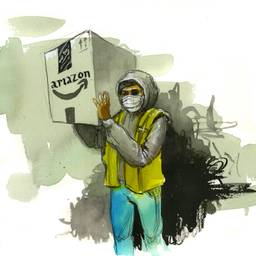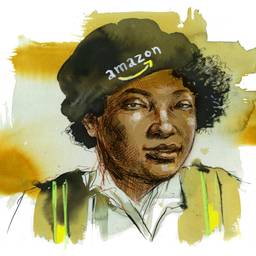Amazon Expects Its Employees to Operate Like Fast-Moving Machines. This Amazon Picker Is Fighting Back.
Inspired by his father and grandfather, Sean Carlisle is organizing to win stronger safety measures for his fellow workers.
Michelle Chen and Molly Crabapple

This article is part of a series on Amazon workers produced in partnership with the Economic Hardship Reporting Project.
For Sean Carlisle (a pseudonym) a 32-year-old graduate student and native of California’s Inland Empire, the last three years at his local Amazon fulfillment center have been an education. As a student of urban planning, he studies how built environments shape a community’s behavior. As a picker, he packs items at a breakneck pace amid stacks of inventory and snaking conveyor belts while delicately practicing strategies to raise his coworkers’ political consciousness.
Amazon’s logistical infrastructure is designed to make humans perform with machine-like efficiency, but Sean is trying to make the workplace a bit more human, advocating for stronger worker protections and corporate accountability in his community.
When he first started at Amazon, Sean enjoyed what he calls a “honeymoon phase.” He liked that workers were promoted readily to managerial positions, especially people with a college education like himself. “They ha[d] all these things that help their employees advance. They have these school programs,” he says, referring to Amazon’s professional education schemes. But about eight months in, he realized “there was some stuff going on here that really could be improved. [I thought] ‘I don’t know if I like this company as much as I did before.’”
“The catalyst was seeing [so many] people get hurt,” he continues. He says workers would tell him, “ ‘I got hurt, and they gave me physical therapy, and I got even more hurt because they didn’t really assess me right and now I have this problem.’ ” It was around the holiday season during his second year “when things hit a significant decline in terms of safety, and there was more focus on productivity.” He says that sometimes workers would accidentally strike the shelves as they navigated forklifts through the center’s aisles, causing the vehicles to tip over.
“The safety problems continued to get worse, and my coworkers and I would say, ‘Hey, [the management has] got to do something about this,’” he recalls.
Sean believes the speed with which workers must process orders — sometimes hundreds of items per hour — leads them to cut corners or ignore problems with their equipment. He says that one byproduct of the relentless pressure to pack more items faster is a high turnover among those who “couldn’t keep up.” Burning through new hires creates a constant churn in the workforce, as temporary workers are cycled in and out during peak seasons.
Amazon’s official data on workplace injuries suggest that many of its fulfillment centers have rates that far exceed the average warehouse. Yet the company claims these statistics are primarily a testament to its meticulous reporting rather than a reflection of its shoddy safety standards. “We ensure we are supporting the people who work at our sites by having first aid trained and certified professionals onsite 24/7, and we provide industry leading health benefits on day one,” a spokesperson said in an email.
Amazon also claims to have spent “over $1 billion [on] new investments in operations safety measures” that include protective technology, sanitization procedures, and training and education programs for workers. The company maintains that it is “continuously learning and improving our programs to prevent future incidents. ”Sean contends that some managers have simply failed to take workplace hazards seriously. He recalled his surprise when a manager told him, “‘if people didn’t feel safe, they wouldn’t go to work.’”
“That’s not how that works, dude,” he muses. “People go to work because they need a paycheck, not because they feel safe.”
While working as a picker, Sean’s academic work led him to a campaign against the planned construction of a huge cargo facility for San Bernardino International Airport. Various community groups, including Teamsters local 1932 and environmental activists, formed the San Bernardino Airport Communities Coalition to oppose the project, which they warn will deepen the economic and environmental exploitation of the region by corporations like Amazon—the area’s largest private employer. Despite a legal challenge brought by the coalition’s leading groups earlier this year, the facility’s construction is moving forward, and Sean has now shifted his focus to helping protect his coworkers from the pandemic.
One practical benefit that Sean and the other organizers aim to secure for workers in the short term is paid leave so that those affected by the pandemic can stay home without sacrificing wages. The company initially provided unlimited unpaid leave for workers who self-isolated due to COVID-19-related health concerns but ended the policy in May. Now Sean is encouraging coworkers to seek benefits under a new state law for food-industry workers that provides up to two weeks paid leave for workers who have been advised by a medical professional to self-isolate or ordered not to work.
Amazon initially argued that it was exempt from the mandate. But as Vice reported in July, community groups and labor activists, along with the state labor commissioner’s office, pressured the company to comply on the grounds that its warehouses serve as major retail food distributors. In June, approximately two months after the order was enacted, Amazon finally agreed to follow the law.
With a poster detailing the state’s new paid-leave policy now on display in the breakroom, Sean says he is advising his coworkers to take advantage of what he calls a legal “loophole” that allows Amazon employees to take paid time off outside of the company’s more restrictive allotment. The workers who qualify have managed to use the law “just to take a break, or reevaluate their situation.”
Sean says that despite his advocacy on behalf of Amazon employees, he has avoided the kind of retaliation from management that other worker-activists have reported.
At the same time, he acknowledges, “I’m also not trying to [provoke] them directly.” When it comes to engaging with his colleagues on workplace justice issues, he says, “Usually, I’ll have a conversation where it just kind of unfolds like, ‘Man, someone in my family just recently passed, and I can’t take time off work.’ And I’m like, ‘Oh, you should check out the law that was just recently passed and I think you can get time off for it.”
Sean is building a safer workplace within Amazon’s e-commerce leviathan one conversation at a time. The son of an ironworker and grandson of a teamster, his sense of mission is informed by the family stories he heard as a child about strikes and picket lines.
Amazon, which has managed to keep unions at bay for years, bears little resemblance to the union shops of past generations. But today’s Amazon warehouse workers and drivers are just as critical to California’s economy as the longshoremen, truck drivers and iron workers were a century ago. “I see Amazon as something that’s probably here to stay and likely going to shape our future and our understanding of American capitalism and consumption,” he says.
Though yesterday’s militant shop-floor struggles have long faded from California’s industrial landscape, the challenges facing the labor movement remain basically the same. When workers organize, Sean says, they can “hold the company accountable and shape it to be the company it is. Without the workers, the company would not be what it is.”
Michelle Chen is a contributing writer at In These Times and The Nation, a contributing editor at Dissent and a co-producer of the “Belabored” podcast. She studies history at the CUNY Graduate Center. She tweets at @meeshellchen.
Molly Crabapple, an artist and writer in New York, is the author of, most recently, Drawing Blood and Brothers of the Gun, (with Marwan Hisham). Her art is in the permanent collections of the Museum of Modern Art. Her animated short, A Message from the Future with Alexandria Ocasio-Cortez, has been nominated for a 2020 Emmy for Outstanding News Analysis: Editorial and Opinion.













